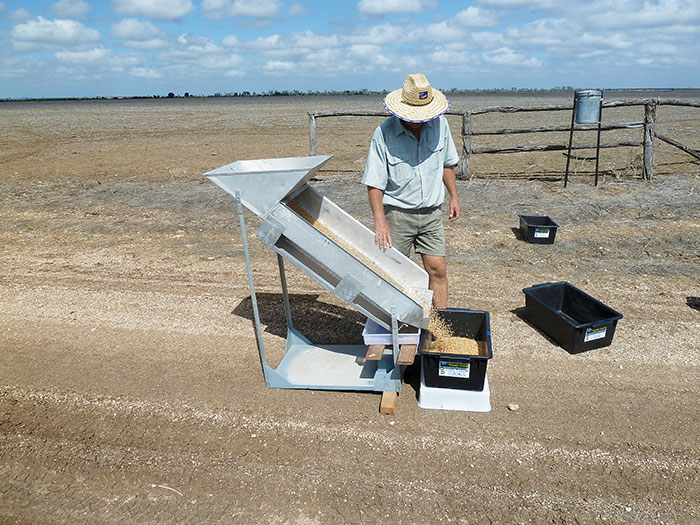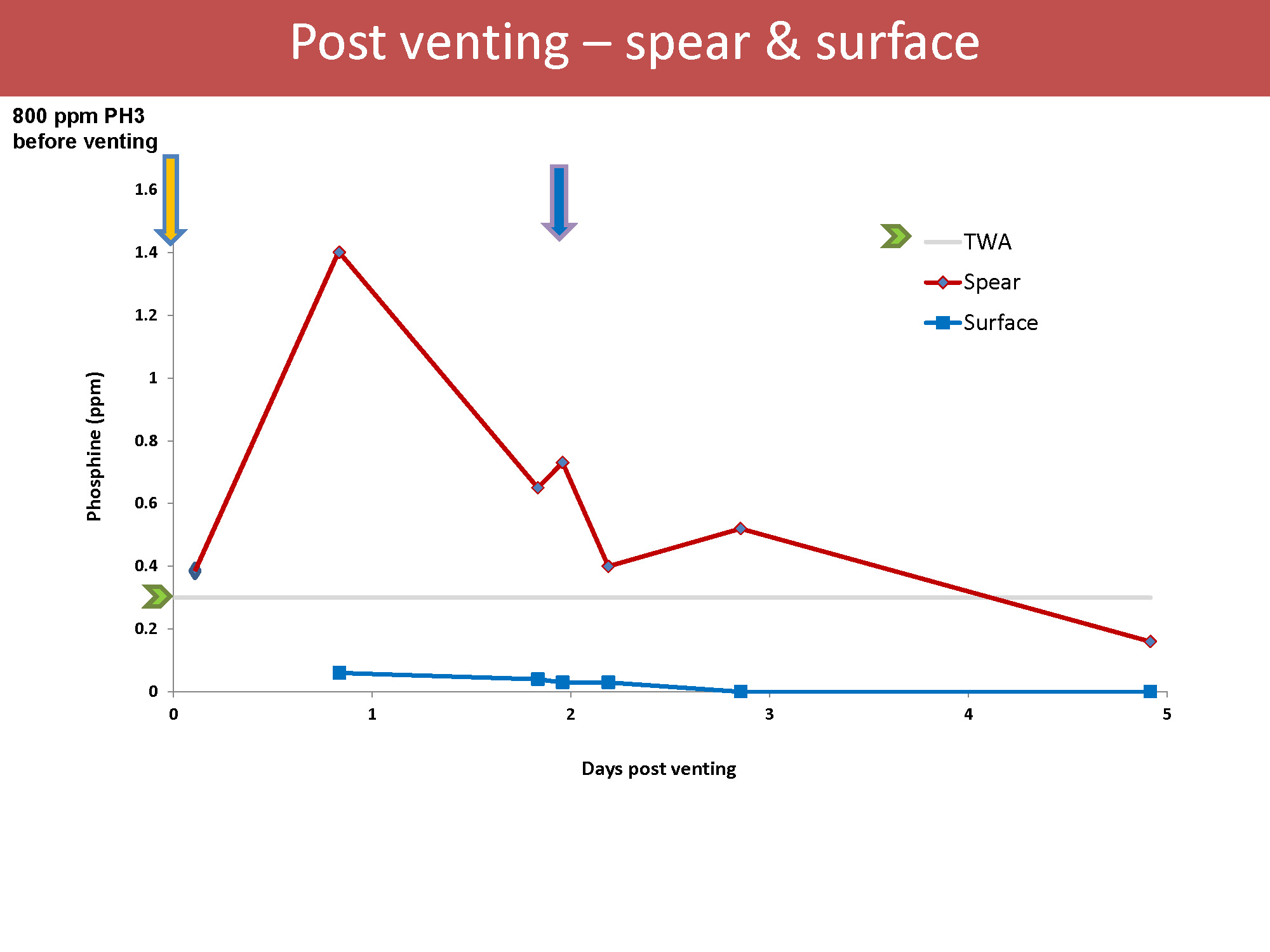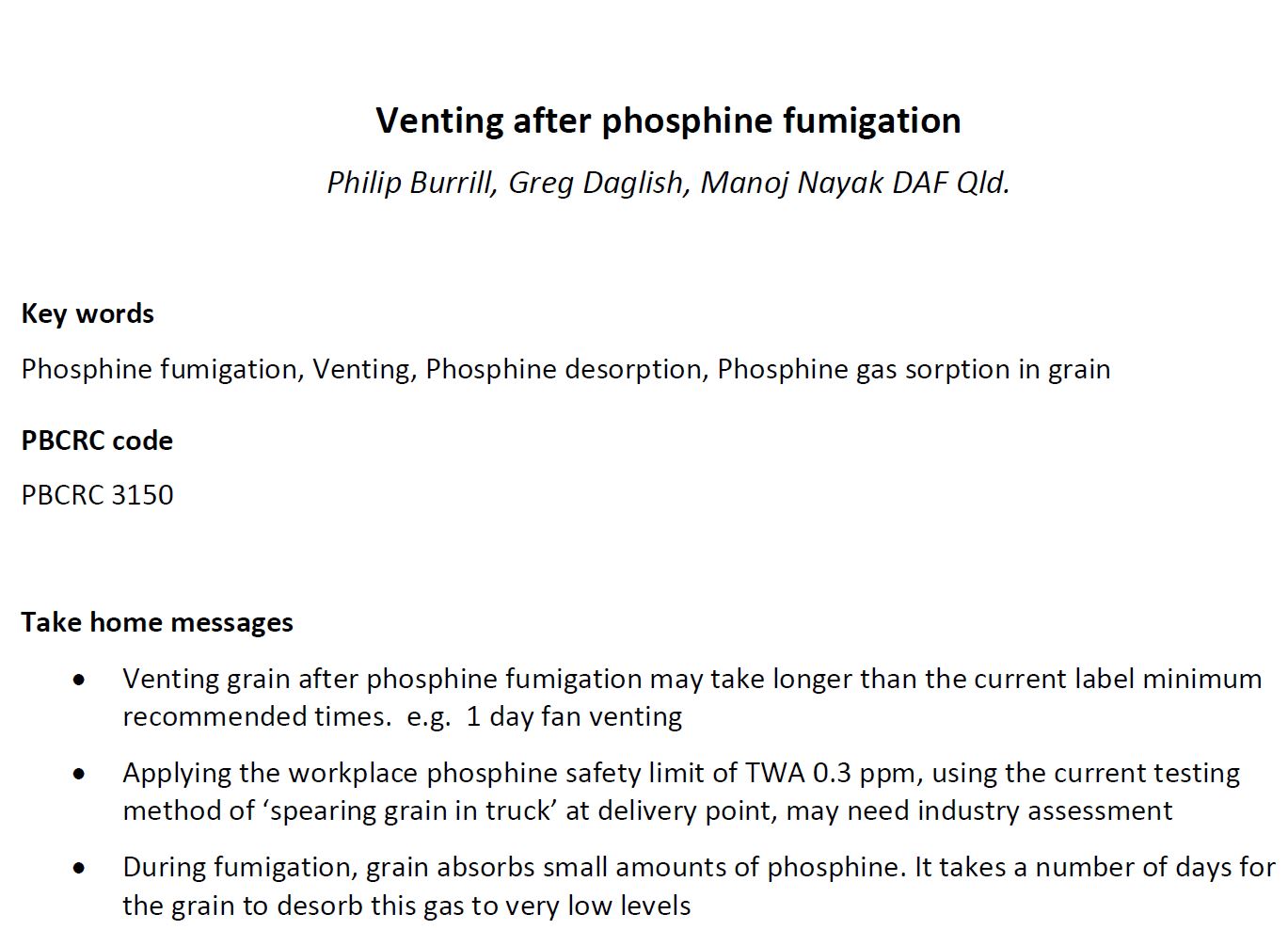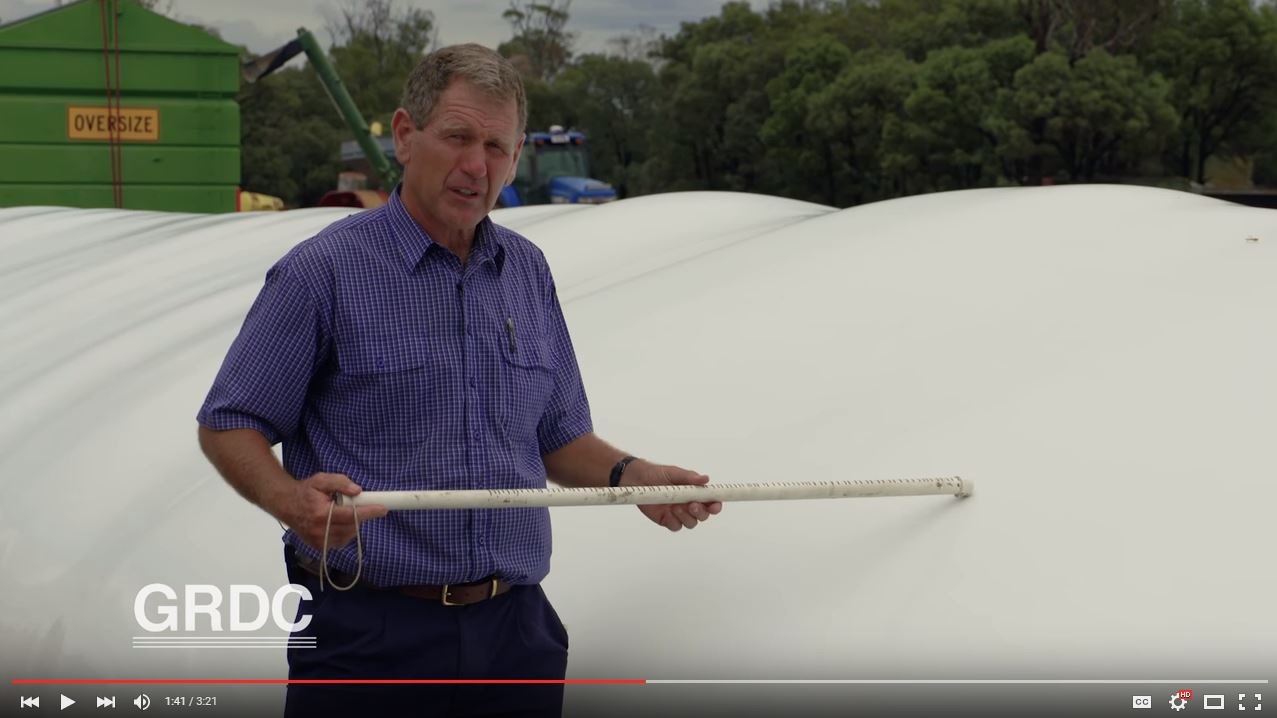Source Link GRDC
Key points
- Grain is most likely to be infested by beetles from your storage facility
- Effective hygiene can delay infestation for at least two months
- Beetles typically fly within a two-kilometre radius to infest another grain storage
- Some beetles can fly more than 100km to infest grain
- Flying beetles are spreading insecticide resistance over large areas

A mini silo filled with 50 litres of wheat set up near existing farm storage.
PHOTO: Dr Andrew Ridley
Infestation of stored grain can sometimes seem inevitable, but storage pests are reliant on a food source that we control. Too often we provide a friendly environment for these pests by failing to detect and deal promptly with infested grain, or clean out empty silos and equipment.
If we are ever going to reduce our reliance on killing pests once they have infested grain, we need to better understand the insects and how they infest our grain storage in the first place.
The results from research conducted on Australian grain farms by the Queensland Department of Agriculture and Fisheries and the University of Queensland offer some helpful instructions for grain storage best practice.
Harvested grain placed into a silo can become infested from two potential sources. First, there may be a residual pest population hiding in grain handling machinery or silos that will be incorporated into freshly harvested grain. Second, pests can move into the grain of their own accord by flying in from infested silos.
A common misconception is that pests are brought in with the crop at harvest time and this is when infestation starts. It is true that insects such as grasshoppers and lady beetles are harvested along with grain, but these field crop pests die quickly in the dry conditions of stored grain.
The majority of stored grain beetles do not infest standing crops, so this is not likely to be the source of the problem. Only if you are harvesting legumes or maize should you be concerned about gathering up unwanted storage pests with your grain.
When harvesting legumes or maize, keep an eye out for adult beetle exit holes (these are hard to miss) or small white eggs glued to the surface of the seeds in grain samples. Also, use an insect sieve for maize and legumes as you are filling silos during harvest. Get pests identified correctly to see if they are field pests or storage pests. When storage pests are detected during harvest, aerate grain initially over the first two weeks to provide safe uniform grain storage conditions, then seal the silo to fumigate pests. Once pests are killed, return to aeration.
Residual pest populations

Dr Philip Burrill of Queensland DAF sieving grain from a mini silo placed 2km from farm storage in Mount McLaren.
PHOTO: Dr Andrew Ridley
Most grain storage beetles are long-lived and can survive on very small amounts of food. Grubs of the red flour beetle (Tribolium castaneum) can survive on the thin layers of grain dust that settles on flat surfaces.
It can be difficult, therefore, to eradicate pests from machinery and storages unless these structures are specifically designed to assist in cleaning. Some silos are made with flat internal surfaces so grain and dust have nothing to cling to. Flat bottom silos with ‘full floor’ aeration are, in contrast, not easy to clean. Removing grain residues in the subfloor area is difficult. Some manufacturers provide a flat bottom silo with channel aeration systems that are simple to clean and just as effective for aeration cooling.
When purchasing new grain storage, take hygiene into account. The silo will be there for a long time and the easier it is to clean the more likely you are to do it.
Grain-handling machinery that contains small amounts of grain can be a source of pests. One header we sampled was hiding more than 1000 lesser grain borers (Rhyzopertha dominica) waiting to be mixed with freshly harvested grain.
Headers, augers, grain dryers and other grain-handling equipment can be cleaned with compressed air and then dusted with a diatomaceous earth product such as Dryacide® to kill any remaining pests.
Likely sources of pests
If you have an existing infestation somewhere at your grain storage facility, your freshly harvested grain will most likely become infested with beetles quickly.

One of the beetle traps set one kilometre from grain storage that caught storage pests flying from one farm to another.
PHOTO: Dr Andrew Ridley
We placed wheat in mini silos (50-litre capacity) near farm silos in central Queensland and sieved the grain after two months. We also looked for pests in the storages on each farm. We found that where a farm already had a particular pest species in storage facilities, it usually infested the clean grain in our nearby mini silos quickly.
We also found that the mini silos were unlikely to become infested by pest species that were not already present on the farm. This demonstrated that hygiene, when done well, can delay the onset of infestation by at least two months. For grains harvested in spring, delaying infestation beyond summer can greatly reduce the need to control pests once temperatures drop in winter and pests are less likely to be flying.
Disposal of old and waste grain that tends to be heavily infested will make the greatest impact on the number of pests in your storage facility.
Even small parcels of grain can produce huge numbers of pests. When 100 beetles each of six pest species were introduced into a 27-kilogram box of wheat, more than 1.5 million beetles were produced over the course of a year. Most of these beetles were caught leaving the infestation.
But how far away do you need to dump waste and infested grain? If possible it is always best to bury, burn or spread (less than 10 millimetres deep) infested waste grain.
Grain in mini silos, which were placed two kilometres away from a storage facility was much less likely to be colonised by flying beetles. Therefore, if possible, separate infested grain from grain you wish to sell insect-free by at least two kilometres. This will significantly decrease the risk of infestation from flying storage pests.
Mixed farming operations have particular challenges in terms of insect-free grain storage. Feed mills are difficult to keep pest free because the continuous flow of grain makes sealing silos for fumigation difficult.
The labour involved in cleaning hoppers and augers leads to exposed parcels of grain highly likely to contain storage pests. If I go to a farm looking for storage pests and see a feed mill, the hopper is the first place I look. Storage piles of cotton seed are also a favoured site for the red flour beetle, a common pest of grain in storage.

Figure 1 Mean (± standard error) number of lesser grain borer (Rhyzopertha dominica) beetles caught in 15 traps baited with R. dominica pheromone lures located at farm storages (red) and in paddocks at least one kilometre from those storages (orange). Traps were active for seven days at each sampling period.
If feed mills and stored commercial grain are co-located, grain protectants can be used on feed grain to reduce the chance of these grains becoming breeding grounds for storage pests. Always check the chemical label and discuss chemical application with potential buyers prior to applying any grain protectant treatments.
It is easy to wonder how you ended up with infested grain despite doing a thorough job of hygiene. Unfortunately, just as pests are moving from silo to silo within a complex, they are also moving between properties. We showed this in southern Queensland, where we set up traps for flying beetles in paddocks at least 1km from farm storage, typically along fencelines. We caught lesser grain borers and red flour beetles throughout the year (Figure 1).
So what you and your neighbours do to manage stored grain pests will have an impact on everyone.
Resistance moves with beetles
The ability to manage grain storage pests with grain protectant insecticides and the fumigant phosphine is extremely valuable to the Australian industry. Nil tolerance for live pests is the standard for receival, so tools to deal with storage pests are crucial.
One of the big downsides of beetles moving from one grain storage to another is the potential spread of resistance to control tools. Long-term storage of grain that relies on multiple applications of phosphine or over-reliance on one type of grain protectant – or ineffective fumigation due to silos not being sealed correctly – will result in selection for resistant populations that are harder to kill. These difficult-to-control pests then fly off and infest other parcels of grain.
We can measure the relationships of beetles from different farms using genetics. What we found, after sampling farms in the Southern Downs district of Queensland, is that there has been enough movement to make all beetles from an area of more than 4000 square kilometres become part of ‘one big family’.
This means when one person does the wrong thing and allows selection for resistance, these harder-to-kill beetles are moving to other farms. Using this population genetics technique we estimate that some beetles have travelled more than 100km.
The movement of resistance genes is particularly important when we consider the rusty grain beetle (Cryptolestes ferrugineus). This beetle has become very difficult to kill with phosphine compared with other pests.
Stored grain beetles are hard to control, but with access to treatments and quality storage, Australian growers are some of the best at delivering high-quality grain. Better planning to limit the pressure of insect infestation on your grain will help protect our current treatments and maintain Australia’s good reputation.
More information:
Dr Greg Daglish,
07 3708 8538,
greg.daglish@daf.qld.gov.au
Philip Burrill,
0427 696 500,
philip.burrill@daf.qld.gov.au
GRDC Project Code Plant Biosecurity Cooperative Research Centre Codes CRC50089, CRC50149, CRC3039
Region National





